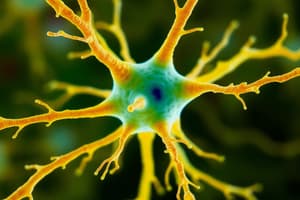Podcast
Questions and Answers
What is the primary function of the Nodes of Ranvier?
What is the primary function of the Nodes of Ranvier?
- They form synapses with other neurons.
- They enable faster signal transmission by allowing action potentials to jump between nodes. (correct)
- They release neurotransmitters into the synapse.
- They increase the neuron's resting membrane potential.
Na+ ions are responsible for repolarization during an action potential.
Na+ ions are responsible for repolarization during an action potential.
False (B)
What are the three components of the cytoskeleton in neurons?
What are the three components of the cytoskeleton in neurons?
Microtubules, neurofilaments, and microfilaments.
The process where action potentials jump from node to node along a myelinated axon is called ______.
The process where action potentials jump from node to node along a myelinated axon is called ______.
Match the following ion functions with their roles in action potentials:
Match the following ion functions with their roles in action potentials:
What is the primary function of dendrites?
What is the primary function of dendrites?
The myelin sheath slows down signal transmission along the axon.
The myelin sheath slows down signal transmission along the axon.
What is the resting membrane potential of a neuron, typically measured in millivolts?
What is the resting membrane potential of a neuron, typically measured in millivolts?
The _____ are immune cells in the brain responsible for clearing debris.
The _____ are immune cells in the brain responsible for clearing debris.
Match the types of neurons with their primary characteristics:
Match the types of neurons with their primary characteristics:
What happens during the repolarization phase of an action potential?
What happens during the repolarization phase of an action potential?
Synaptic transmission is the process of signal transfer from one neuron to another.
Synaptic transmission is the process of signal transfer from one neuron to another.
What is the threshold for an action potential?
What is the threshold for an action potential?
Flashcards
Neurons
Neurons
The fundamental units of the nervous system responsible for transmitting signals.
Soma
Soma
The cell body of a neuron containing the nucleus and organelles.
Dendrites
Dendrites
Branch-like extensions that receive signals from other neurons.
Axon
Axon
Signup and view all the flashcards
Axon Terminals
Axon Terminals
Signup and view all the flashcards
Myelin Sheath
Myelin Sheath
Signup and view all the flashcards
Nodes of Ranvier
Nodes of Ranvier
Signup and view all the flashcards
Resting Membrane Potential
Resting Membrane Potential
Signup and view all the flashcards
Depolarization
Depolarization
Signup and view all the flashcards
Repolarization
Repolarization
Signup and view all the flashcards
Threshold
Threshold
Signup and view all the flashcards
Excitatory Signals
Excitatory Signals
Signup and view all the flashcards
Inhibitory Signals
Inhibitory Signals
Signup and view all the flashcards
Study Notes
Neuron Structure and Function
- Neurons are the fundamental units of the nervous system, responsible for transmitting signals.
- Key components of a neuron:
- Soma (cell body): Contains the nucleus and organelles for cell metabolism.
- Dendrites: Receive signals from other neurons.
- Axon: Transmits signals away from the cell body.
- Axon terminals (postsynaptic terminals): Neurotransmitter release occurs here.
- Myelin sheath: Protects and speeds up signal transmission along the axon.
- Nodes of Ranvier: Gaps in the myelin sheath, allowing for faster signal propagation.
Neuron Types
- Multipolar neuron: Has multiple dendrites and one axon, common in the central nervous system (CNS).
- Bipolar neuron: Found in sensory organs, has one dendrite and one axon.
- Interneurons: Connect other neurons within the CNS.
Glial Cells
- Oligodendrocytes: Myelin sheath formation in the CNS.
- Astrocytes: Provide support, regulate neurotransmitters, and maintain ion balance.
- Microglia: Immune cells, clearing debris in the brain.
Action Potentials
- Depolarization: Na+ ions enter the neuron, making the inside more positive.
- Repolarization: K+ ions flow out, restoring the negative charge inside the neuron.
- Resting membrane potential: Stable, negative charge inside a neuron, typically -70mV.
- Refractory period: A period following an action potential when the neuron cannot fire again.
- Threshold: The minimum stimulation level required to trigger an action potential.
- All-or-nothing events: Action potentials fire fully once the threshold is reached, or not at all.
- Action potential propagation: Moves in a wave-like manner along the axon, jumping between Nodes of Ranvier in myelinated axons.
Synaptic Transmission
- Synaptic Transmission: The process of signal transfer from one neuron to another at the synapse.
- Excitatory signals: Bring the next neuron closer to firing.
- Inhibitory signals: Reduce the likelihood of firing.
- Synaptic plasticity: The ability of synapses to strengthen or weaken over time based on activity, crucial for learning and memory.
Ion Channels and Pumps
- Ligand-gated ion channels: Open in response to the binding of specific molecules like neurotransmitters.
- Ion pumps: Use ATP to transport ions against their concentration gradients, maintaining the resting membrane potential.
- Leakage channels: Always open, allowing ions to passively move across the cell membrane.
Other Important Concepts
- Saltatory conduction: The process where action potentials jump from node to node along a myelinated axon.
- Cytoskeleton components: Microtubules, neurofilaments, and microfilaments, providing structural support and maintaining the shape of the neuron.
Studying That Suits You
Use AI to generate personalized quizzes and flashcards to suit your learning preferences.




